Chengxin Liu
CLIP-guided Source-free Object Detection in Aerial Images
Jan 10, 2024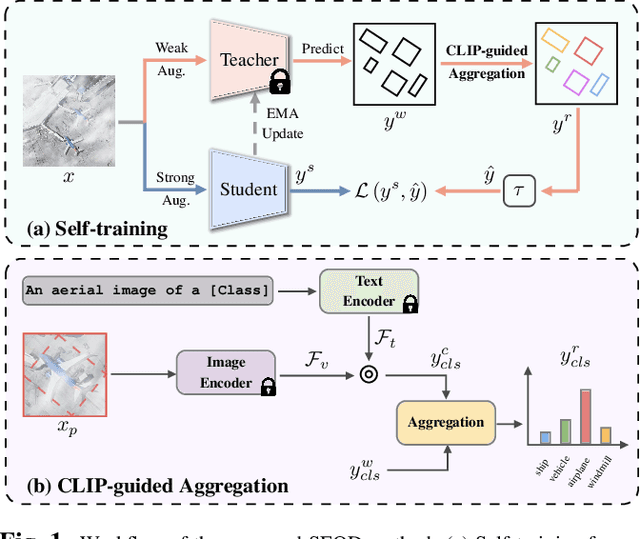

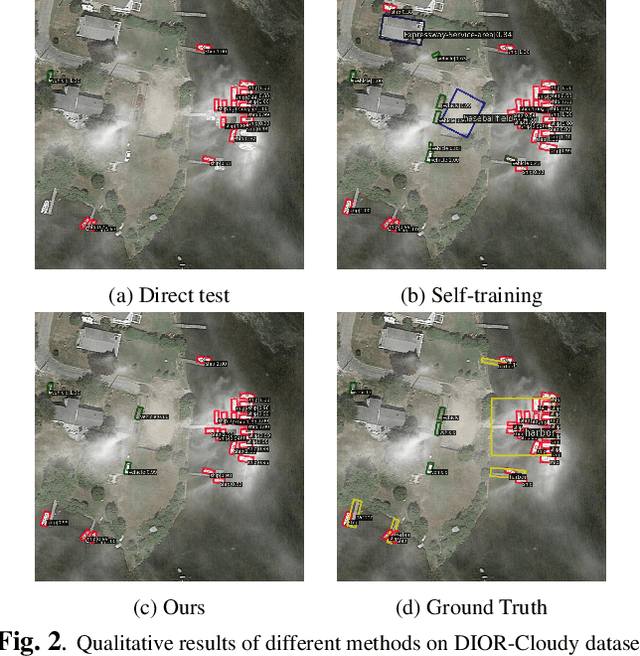
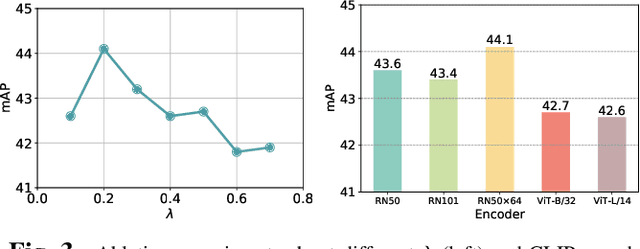
Abstract:Domain adaptation is crucial in aerial imagery, as the visual representation of these images can significantly vary based on factors such as geographic location, time, and weather conditions. Additionally, high-resolution aerial images often require substantial storage space and may not be readily accessible to the public. To address these challenges, we propose a novel Source-Free Object Detection (SFOD) method. Specifically, our approach is built upon a self-training framework; however, self-training can lead to inaccurate learning in the absence of labeled training data. To address this issue, we further integrate Contrastive Language-Image Pre-training (CLIP) to guide the generation of pseudo-labels, termed CLIP-guided Aggregation. By leveraging CLIP's zero-shot classification capability, we use it to aggregate scores with the original predicted bounding boxes, enabling us to obtain refined scores for the pseudo-labels. To validate the effectiveness of our method, we constructed two new datasets from different domains based on the DIOR dataset, named DIOR-C and DIOR-Cloudy. Experiments demonstrate that our method outperforms other comparative algorithms.
Point-Query Quadtree for Crowd Counting, Localization, and More
Aug 26, 2023



Abstract:We show that crowd counting can be viewed as a decomposable point querying process. This formulation enables arbitrary points as input and jointly reasons whether the points are crowd and where they locate. The querying processing, however, raises an underlying problem on the number of necessary querying points. Too few imply underestimation; too many increase computational overhead. To address this dilemma, we introduce a decomposable structure, i.e., the point-query quadtree, and propose a new counting model, termed Point quEry Transformer (PET). PET implements decomposable point querying via data-dependent quadtree splitting, where each querying point could split into four new points when necessary, thus enabling dynamic processing of sparse and dense regions. Such a querying process yields an intuitive, universal modeling of crowd as both the input and output are interpretable and steerable. We demonstrate the applications of PET on a number of crowd-related tasks, including fully-supervised crowd counting and localization, partial annotation learning, and point annotation refinement, and also report state-of-the-art performance. For the first time, we show that a single counting model can address multiple crowd-related tasks across different learning paradigms. Code is available at https://github.com/cxliu0/PET.
Robust Object Detection With Inaccurate Bounding Boxes
Jul 20, 2022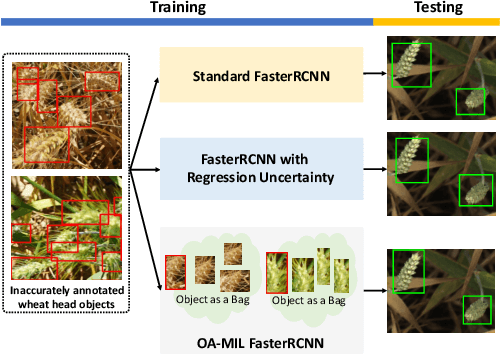
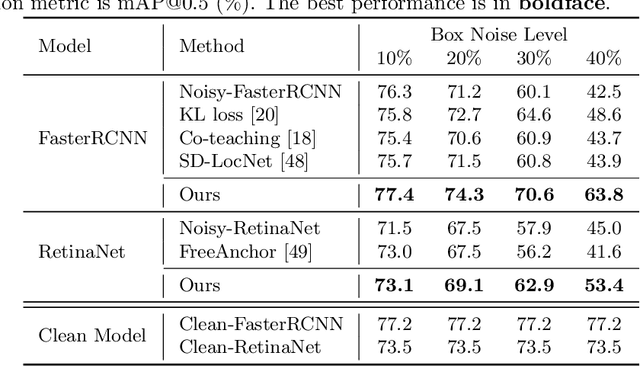
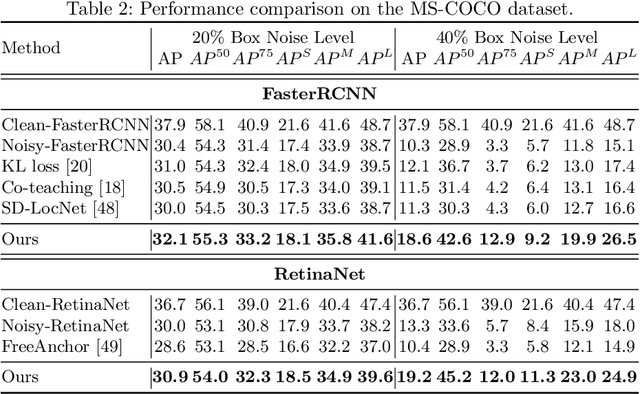
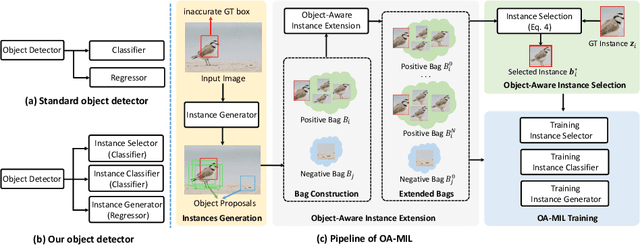
Abstract:Learning accurate object detectors often requires large-scale training data with precise object bounding boxes. However, labeling such data is expensive and time-consuming. As the crowd-sourcing labeling process and the ambiguities of the objects may raise noisy bounding box annotations, the object detectors will suffer from the degenerated training data. In this work, we aim to address the challenge of learning robust object detectors with inaccurate bounding boxes. Inspired by the fact that localization precision suffers significantly from inaccurate bounding boxes while classification accuracy is less affected, we propose leveraging classification as a guidance signal for refining localization results. Specifically, by treating an object as a bag of instances, we introduce an Object-Aware Multiple Instance Learning approach (OA-MIL), featured with object-aware instance selection and object-aware instance extension. The former aims to select accurate instances for training, instead of directly using inaccurate box annotations. The latter focuses on generating high-quality instances for selection. Extensive experiments on synthetic noisy datasets (i.e., noisy PASCAL VOC and MS-COCO) and a real noisy wheat head dataset demonstrate the effectiveness of our OA-MIL. Code is available at https://github.com/cxliu0/OA-MIL.
Represent, Compare, and Learn: A Similarity-Aware Framework for Class-Agnostic Counting
Mar 16, 2022



Abstract:Class-agnostic counting (CAC) aims to count all instances in a query image given few exemplars. A standard pipeline is to extract visual features from exemplars and match them with query images to infer object counts. Two essential components in this pipeline are feature representation and similarity metric. Existing methods either adopt a pretrained network to represent features or learn a new one, while applying a naive similarity metric with fixed inner product. We find this paradigm leads to noisy similarity matching and hence harms counting performance. In this work, we propose a similarity-aware CAC framework that jointly learns representation and similarity metric. We first instantiate our framework with a naive baseline called Bilinear Matching Network (BMNet), whose key component is a learnable bilinear similarity metric. To further embody the core of our framework, we extend BMNet to BMNet+ that models similarity from three aspects: 1) representing the instances via their self-similarity to enhance feature robustness against intra-class variations; 2) comparing the similarity dynamically to focus on the key patterns of each exemplar; 3) learning from a supervision signal to impose explicit constraints on matching results. Extensive experiments on a recent CAC dataset FSC147 show that our models significantly outperform state-of-the-art CAC approaches. In addition, we also validate the cross-dataset generality of BMNet and BMNet+ on a car counting dataset CARPK. Code is at tiny.one/BMNet
From Open Set to Closed Set: Supervised Spatial Divide-and-Conquer for Object Counting
Jan 07, 2020



Abstract:Visual counting, a task that aims to estimate the number of objects from an image/video, is an open-set problem by nature, i.e., the number of population can vary in [0, inf) in theory. However, collected data and labeled instances are limited in reality, which means that only a small closed set is observed. Existing methods typically model this task in a regression manner, while they are prone to suffer from an unseen scene with counts out of the scope of the closed set. In fact, counting has an interesting and exclusive property---spatially decomposable. A dense region can always be divided until sub-region counts are within the previously observed closed set. We therefore introduce the idea of spatial divide-and-conquer (S-DC) that transforms open-set counting into a closed-set problem. This idea is implemented by a novel Supervised Spatial Divide-and-Conquer Network (SS-DCNet). Thus, SS-DCNet can only learn from a closed set but generalize well to open-set scenarios via S-DC. SS-DCNet is also efficient. To avoid repeatedly computing sub-region convolutional features, S-DC is executed on the feature map instead of on the input image. We provide theoretical analyses as well as a controlled experiment on toy data, demonstrating why closed-set modeling makes sense. Extensive experiments show that SS-DCNet achieves the state-of-the-art performance. Code and models are available at: https://tinyurl.com/SS-DCNet.
From Open Set to Closed Set: Counting Objects by Spatial Divide-and-Conquer
Aug 15, 2019



Abstract:Visual counting, a task that predicts the number of objects from an image/video, is an open-set problem by nature, i.e., the number of population can vary in $[0,+\infty)$ in theory. However, the collected images and labeled count values are limited in reality, which means only a small closed set is observed. Existing methods typically model this task in a regression manner, while they are likely to suffer from an unseen scene with counts out of the scope of the closed set. In fact, counting is decomposable. A dense region can always be divided until sub-region counts are within the previously observed closed set. Inspired by this idea, we propose a simple but effective approach, Spatial Divide-and- Conquer Network (S-DCNet). S-DCNet only learns from a closed set but can generalize well to open-set scenarios via S-DC. S-DCNet is also efficient. To avoid repeatedly computing sub-region convolutional features, S-DC is executed on the feature map instead of on the input image. S-DCNet achieves the state-of-the-art performance on three crowd counting datasets (ShanghaiTech, UCF_CC_50 and UCF-QNRF), a vehicle counting dataset (TRANCOS) and a plant counting dataset (MTC). Compared to the previous best methods, S-DCNet brings a 20.2% relative improvement on the ShanghaiTech Part B, 20.9% on the UCF-QNRF, 22.5% on the TRANCOS and 15.1% on the MTC. Code has been made available at: https://github. com/xhp-hust-2018-2011/S-DCNet.
 Add to Chrome
Add to Chrome Add to Firefox
Add to Firefox Add to Edge
Add to Edge